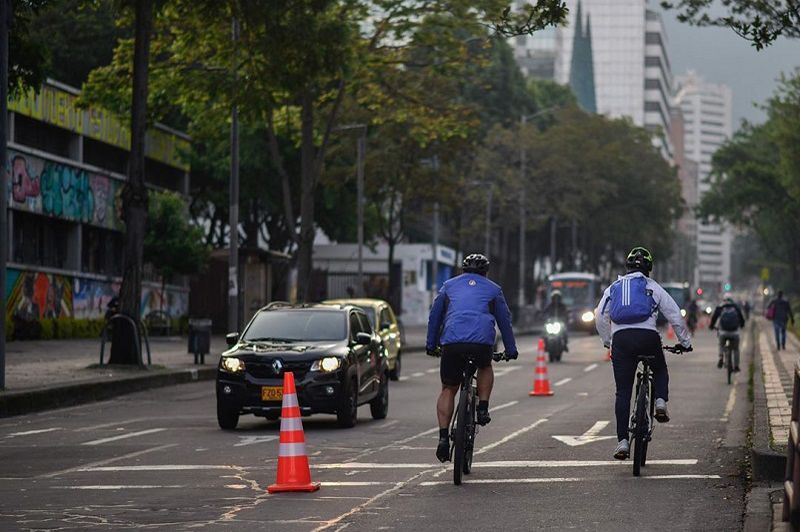The EUROCLIMA+/MobiliseYourCity Community of Practice promotes actions for bicycle mobility.
Mexico City, July 7, 2020. – The COVID-19 pandemic has claimed more than half a million lives worldwide. Because it is easily contagious and because it is a new disease that has no cure as yet, the most effective measures that countries have taken are generating restrictions on mobility and promoting social distancing with calls to avoid leaving home, discourage travel, and suspend non-essential activities.
However, there are activities and needs for which people do need to be mobilised. What means of transportation do they choose to do so? Given the possible lack of confidence in public transport and as a more sustainable alternative to private cars, the bicycle is an excellent option, as it avoids crowds and facilitates social distancing.
Many governments have opted for this individual and non-motorised transport as an action for mobility in dealing with the COVID-19 crisis. The United Nations Environment Programme considers investment in facilitating pedestrian options and cycling as vital in helping to save lives and protect the environment.
Through the Platform for Sustainable Urban Mobility in Latin America, the EUROCLIMA+/MobiliseYourCity Community of Practice highlights the importance of learning about these experiences. For this reason, the initiatives taken by cities such as Bogotá, Mexico City and London are presented below, shared in the framework of the webinar "Actions for bicycle mobility before the COVID-19", which was held on April 2.
Bogotá’s experience
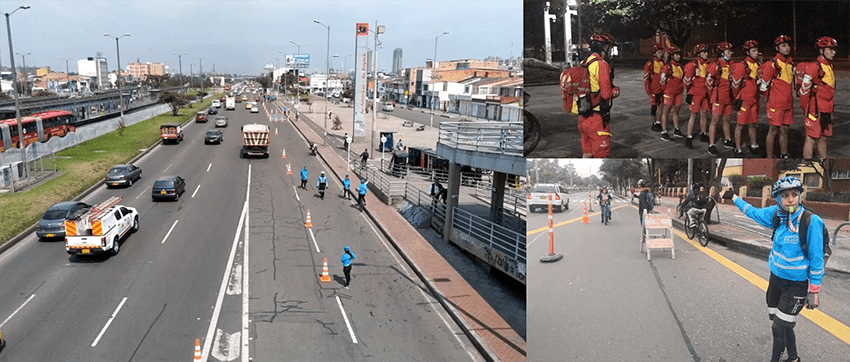
During the last few years, this Colombian city has encouraged the use of bicycles. Every day, 880 thousand trips are made using this means of transport. Bogotá, Colombia, has 550 kilometres of bicycling infrastructure and more than one and a half million bicycles.
When the crisis began, actions were proposed to facilitate an individual, affordable, and convenient means of alternative transport for users that would help reduce crowding in public transport.
“This has been a challenge and a positive aspect in confronting these new circumstances with new ideas,” said Laura Leticia Baamon, manager of Bogotá bicycling.
Thus, through inter-institutional coordination involving sport, mobility, police, public transport companies and the Risk Management Institute, the following actions were carried out
- Implementation of a network of temporary cycle paths mirroring transport routes in four phases.
- Adjustments to traffic light scheduling to be more cyclist friendly
- Signalling operations and regulation of bicycle paths, for road safety.
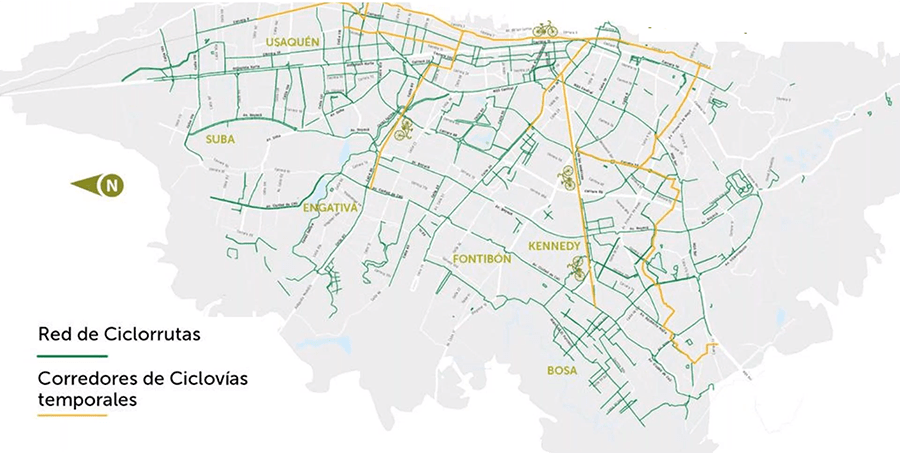
Regarding the temporary cycle path routes, these were adapted according to demand and mobility restrictions as the pandemic progressed. 22 km were installed in the first phase; 117 km in the second; 76 km in the third; and 35 km in the fourth. In terms of use, demand ranged from five thousand to seven thousand cyclists.
In order to execute these actions, it was very helpful to use previous experiences in promoting bicycle use. The aim was to speed up the response to the pandemic, and the methodology used included constant counts, surveys, and diagnostics. It should be clarified that these actions are only aimed at those who do have a need to go out, since there are legal restrictions on occupying public space.
Some challenges have yet to be resolved, such as the theft of cones to mark cycle paths, the invasion of confined space by taxis and motorcycles, or the danger of cars speeding along the emptiest streets. These measures were widely accepted by the public. A total of 66.9% rated them as excellent and 18.6% as good.
Initiatives for Mexico City

As one of the largest and most populated regions in Latin America, Mexico City has also faced challenges from COVID-19 and initiatives have been taken on mobility issues. In the case of actions for the use of bicycles, Nubia Martinez, Director of Mobility in Miguel Hidalgo Township participated.
The Mayor's Office is one of the most important financial, economic, and social centres of the Mexican city, so in order to avoid conglomerations of people, they chose to promote the use of bicycles. A temporary 1.7 km bicycle lane was installed as a pilot test on Avenida Cervantes de Saavedra: "It is a measure on a different scale from that of Bogotá. In a way, this is just the first exercise. Surely after that we will have extensive teaching and we will be able to do this in a better way", commented Nubia.
The bike path has been operating from Mondays to Fridays and it is located in an area complicated by its use of commercial, office and residential spaces. On its first day of use it had a capacity of 313 cyclists and a total of 909 in the first week. As for the user profile, they have detected that it is mainly used by delivery companies for food delivery applications.
"Today they are certainly doing a very important job: bringing products into our homes. We think it is very important for them to have this space where they are sometimes taking so many risks," explained Nubia Martinez.
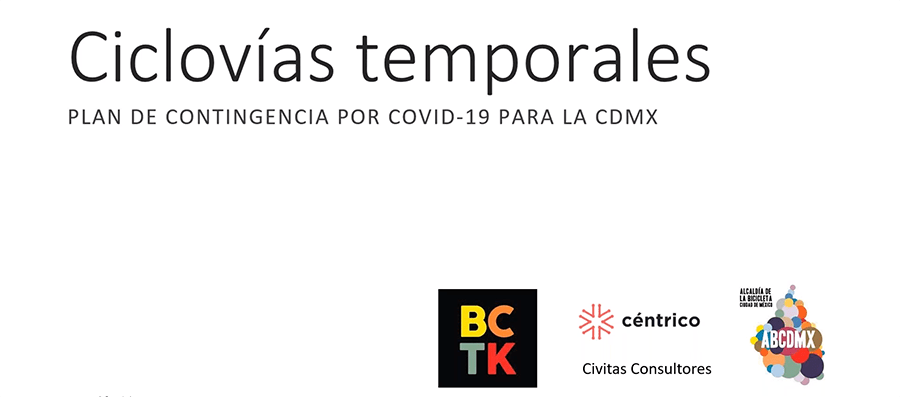
In recent weeks, Mexico City has begun to implement larger scale emerging bike paths on two important roads: 18 kilometres on Avenida Insurgentes, one of the most important roads in the city; and 14 kilometres on the Eje 4 Sur Xola.
These initiatives were presented in the study "Temporary bike paths. Contingency Plan for COVID-19 for the CDMX", prepared by Mexico City’s Bicycle City Hall in conjunction with other organisations and presented in the webinar by Xavier Treviño, co-director of Céntrico.
"What we don't want is for public transport to be an element that multiplies the contagion. What we need is for this not to be the issue," said the speaker. This is due to the fact that Mexico City has been one of cities with the least reduction in Latin America at 61% (against 91% reduction in Lima or 79% in Bogotá).
To this end, the promotion of bicycle use is an initiative that has been demanded by several organisations. According to Xavier, this non-motorised transport has major immediate and long-term benefits:
- Increased separation between public transport users.
- Increased separation between pedestrians and cyclists in the streets.
- Reduced risk of hospitalisation due to obesity-related diseases
- Reduced risk of death due to better physical conditioning.
- Reductions in the risk of respiratory diseases related to vehicle emissions.
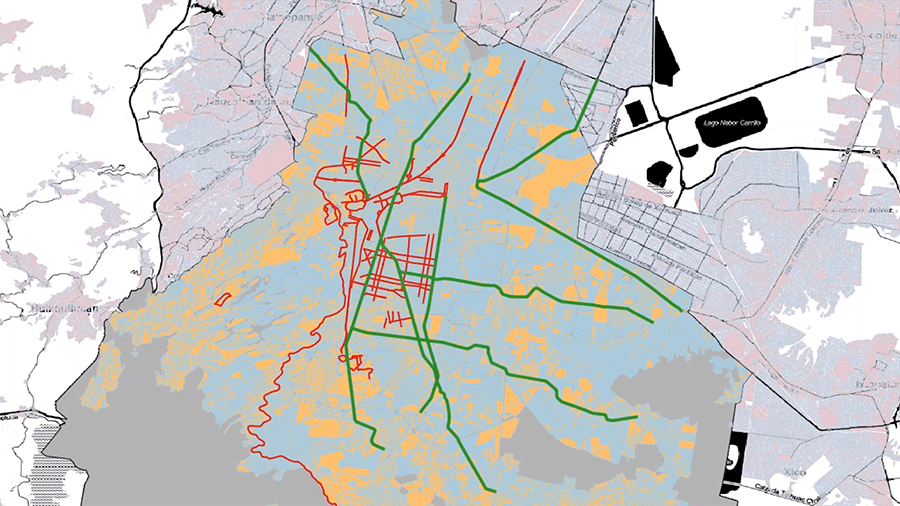
That is why they decided to make a proposal consistent with the implementation of bicycle lanes on roads that concentrate a high demand for travel in the city (such as Avenida Insurgentes), roads that pass alongside high demand mass transport, and in areas that already have a high demand for bicycle travel.
The methodology of the study consisted of a survey with open questions for bicycle users on social networks, following a closed question to measure the acceptance of the proposed roadways. Finally, a multi-criteria matrix was made (acceptance, usefulness in mobility, physical characteristics of adaptation to the cycle path, connection with public transport corridors and coverage in the area) about the 25 candidate roads to qualify those that would be viable or not for building the new cycle paths.
The challenges in London
Finally, Dr. Rachel Aldred, Director of the Active Travel Academy at the University of Westminster, commented on the challenges they are facing in London, UK, in terms of mobility.
After first applauding the measures presented by the initiatives in Latin America, the speaker explained that in her region there have been very radical changes in mobility restrictions and that the use of bicycles has yet to be encouraged.
"Of course we need effective policies against the virus, but we also need to consider the impact of these policies on other risks. A major problem is physical activity, which in Europe kills hundreds of thousands of people every year," she said.
She said that confinement has affected the physical activity of people who used to go walking to get to work. This can have serious physical and mental health consequences, as more than half of London's homes are in apartments, she said.
That is why she sent, together with 100 other experts, a letter to the government in which they expressed the need to defend the need and right to exercise, such as walking or cycling. However, London is still a very dangerous city for cyclists, as it does not have enough cycling structures.
While there has been an increase in the use of shared bicycle rentals, there have not yet been other actions such as temporary bicycle paths. "We have a lot to do to keep spaces safe for biking and walking. People should be encouraged to not use the car unless it's necessary. Now and forever as needed”.
You can see the complete video of the webinar “Actions for bicycle mobility against COVID-19” and download the materials at this link
About EUROCLIMA+
EUROCLIMA+ is a programme financed by the European Union to promote environmentally sustainable and climate-resilient development in 18 Latin American countries, particularly for the benefit of the most vulnerable populations. The Programme is implemented under the synergistic work of seven agencies: the Spanish Agency for International Development Cooperation (AECID), the French Development Agency (AFD), the Economic Commission for Latin America and the Caribbean (ECLAC), Expertise France (EF), International and Ibero-American Foundation for Administration and Public Policy (FIIAPP), the German Society for International Cooperation (GIZ), and UN Environment.
For more information:
This email address is being protected from spambots. You need JavaScript enabled to view it.
www.euroclimaplus.org
